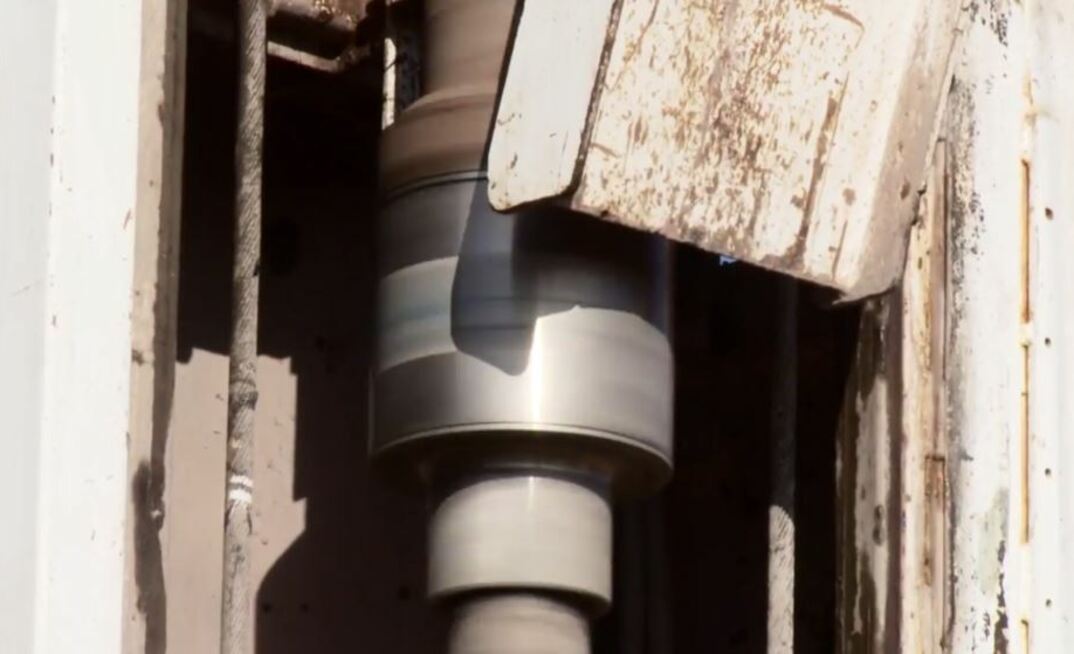Wallis Drilling’s Delta 1 automated rig has shed some light on this possible future.
So too have some of the developments from the Deep Exploration Technology Cooperative Research Centre in South Australia.
The Delta 1 can load and thread the drill rods itself and trip them out of the hole itself too. The system actually slows, and even reverses, the rotation to ensure the thread on each rod is not damaged.
Watching the rig in action it is more telling to see what the driller does not do rather than what they actually do.
That driller is operating the rig via a wireless control panel several metres from the rig – well clear of the fall zone around the mast where most of the drill controls usually are.
That wireless connection is via Bluetooth, although there are cable back-up options available if necessary.
Because the rig loads its own rods, there is no need for the drilling offsider who would have to stand in the fall zone to do that task.
The other thing Wallis has done is move the sample collection point several metres up the rig so the offsider collecting the samples is out of the fall zone too.
That means nobody has to be in the fall zone while the rig is operating.
The rig will do away with at least one offsider. That is one offsider who will not need to be flown to site and accommodated.
Great for Wallis and the guys operating it on Rio Tinto’s West Angelas iron ore mine where the Delta 1 started work last month.
However, imagine if it was autonomous, instead of just automatic.
It seems that with a few tweaks of the system, the drill operator will not really need to be there and the machine could start drilling for itself.
Autonomous blast hole drill rigs are becoming more common in the Pilbara. Why not a reverse circulation drill rig looking after its own drilling?
One of the technologies out of the DET CRC is the Wireless Sub.
That technology, which has been licenced to Boart Longyear, couples the drill rig to the drill rods in the hole and provides real-time measurement of additional, and more accurate, parameters than provided by traditional drill rig gauges.
Combined with drilling optimisation software this data lets drillers of any level of experience rapidly determine the most effective drilling parameters.
Take this a step further and it will allow a machine to replicate or even surpass the output of a highly skilled and experienced human driller.
So that allows the driller joins the rod loading offsider on the sidelines.
Some assumptions have to be made though. One is that the technology is available to let the rig can drive itself out to the exploration site and back again.
It is obviously quite a step up from a driverless car going down the highway or a haul truck plying a haul road to guiding a truck mounted drill rig through the Australian bush. All the same the problems presented by off road driving will no doubt eventually be surmounted.
So assume there is no need for the driller and no need for the driver. Does that mean the offsider handling the samples just has to along for the ride?
Well, no and better yet, the geologists back at camp or even back in the city could possibly even get assay results as the rig is working.
Just look at the lab-at-rig technology that has come out of the DET CRC.
That technology and other lab-at-rig technologies are being commercialised by Australian Securities Exchange-listed company Imdex.
Those systems take the drill samples as they come out of the rig and turn out an almost instant reading of what is there.
Put all these things together and we may not be too far away from a situation where the rig drives itself out to the area to be explored, sets itself up, drills, analyses its drill samples and reports back.
Imdex global product manager geosciences James Cleverly said the idea of a fully automated lab-at-rig set up was not reality – yet.
“We’re still a way off that,” he said.
“Automation is a very complex beast.
“One of the challenges we face in our industry is for people to understand what they need in real time as opposed to in 24 hours or six weeks’ time.
“There is a cost to automation and that has to be reflected in the price.”
However, he agrees that the technology is reaching a point where what seemed the realms of science fiction could soon become science fact.

























